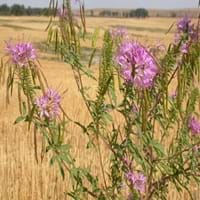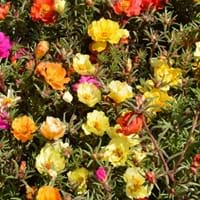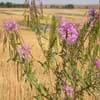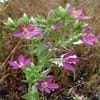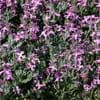Type
Herbs, Vegetable
Flowering Plants
Origin
South America, Argentina, Brazil
South America
Types
Skunk weed, Navajo spinach
Not available
Habitat
foothill woods, open Woodlands, Prairies, Roadsides
gardens, Roadsides, Waste areas
USDA Hardiness Zone
3-10
5-11
AHS Heat Zone
12 - 1
12 - 1
Sunset Zone
1a, 1b, 2a, 2b, 3a, 3b, 4, 5, 6, 7, 8, 9, 10, 11, 12, 13, 14, 15, 16, 17, 18, 19, 20, 21, 22, 24
A1, A2, A3, H1, H2, 1a, 1b, 2a, 2b, 3a, 3b, 4, 5, 6, 7, 8, 9, 10, 11, 12, 13, 14, 15, 16, 17, 18, 19, 20, 21, 22, 23, 24
Habit
Upright/Erect
Prostrate/Trailing
Flower Color Modifier
Bicolor
Bicolor
Fruit Color
Green
Not Available
Leaf Color in Spring
Green
Green
Leaf Color in Summer
Green
Green
Leaf Color in Fall
Green
Green
Leaf Color in Winter
Light Green
Light Green
Leaf Shape
Small elliptic
Needle like
Plant Season
Summer
Summer, Fall
Sunlight
Full Sun
Full Sun
Growth Rate
Fast
Very Fast
Type of Soil
Sand
Loam, Sand
The pH of Soil
Acidic, Neutral
Neutral, Alkaline
Soil Drainage
Well drained
Well drained
Bloom Time
Summer, Late Summer
Indeterminate
Tolerances
Cold climate
Drought, Heat Tolerance
Where to Plant?
Container, Ground
Container, Ground, Pot
How to Plant?
Seedlings
Seedlings
Plant Maintenance
Low
Low
Watering Requirements
Medium, Requires regular watering, Requires watering in the growing season, Water occasionally
Average Water Needs
In Summer
Lots of watering
Lots of watering
In Spring
Moderate
Moderate
In Winter
Average Water
Average Water
Soil pH
Neutral, Slightly Acidic
Acidic, Neutral, Slightly Acidic
Soil Type
Sandy, Well drained
Well drained
Soil Drainage Capacity
Sandy, Well drained
Well drained
Sun Exposure
Full Sun
Full Sun
Pruning
Remove damaged leaves, Remove dead or diseased plant parts
Remove damaged leaves, Remove dead branches, Remove dead leaves, Shearing
Fertilizers
All-Purpose Liquid Fertilizer, fertilize in growing season
Requires high amount of nitrogen
Pests and Diseases
Insects, Leaf spot
Aphids, Botrytis Blight, Brown Spots, Gray mold, Root rot, Stem rot
Plant Tolerance
Cold climate
Drought, Heat Tolerance
Flower Petal Number
Single
Semi-Double
Fragrant Bark/Stem
Yes
No
Foliage Texture
Medium
Fine
Foliage Sheen
Matte
Matte
Attracts
Bees, Butterflies
Butterflies
Allergy
Not Available
Not Available
Aesthetic Uses
Landscape Designing
Beautification, Bouquets, Cottage Garden, Ground Cover, Showy Purposes
Beauty Benefits
Not Available
Skin Problems
Environmental Uses
Air purification, Food for insects, Shelter for wildlife
Air purification
Medicinal Uses
Fever
Depurative, Insect Bites, Liver problems, Snakebite, Swelling
Part of Plant Used
Flowers, Leaves, Seeds
Flowers, Leaves, Stem, Whole plant
Other Uses
Decoration Purposes, Making deodorants, Used as a dye, Used As Food, Used for its medicinal properties
Showy Purposes, Used As Food, Used for its medicinal properties
Used As Indoor Plant
Yes
No
Used As Outdoor Plant
Yes
Yes
Garden Design
Edible, Herb
Cottage garden, Edible
Botanical Name
CLEOME hassleriana 'Helen Campbell'
PORTULACA grandiflora
Common Name
Cleome, Spider Flower
Moss Rose, Portulaca, Sundial Scarlet Portulaca
In Hindi
Cleome serrulata
Portulaca
In German
Cleome serrulata
Portulak
In French
Cleome serrulata
portulaca
In Spanish
serrulata cleome
Portulaca
In Greek
Cleome serrulata
Portulaca
In Portuguese
serrulata Cleome
Portulaca
In Polish
cleome serrulata
Portulaca
In Latin
Cleome serrulata
Portulaca
Phylum
Magnoliophyta
Magnoliophyta
Class
Magnoliopsida
Magnoliopsida
Order
Brassicales
Caryophyllales
Family
Cleomaceae
Portulacaceae
Clade
Angiosperms, Eudicots, Rosids
Angiosperms, Core eudicots, Eudicots
Tribe
Not Available
Not Available
Subfamily
Not Available
Not Available
Number of Species
Not Available
Importance of Cleome serrulata and Portulaca
Want to have the most appropriate plant for your garden? You might want to know the importance of Cleome serrulata and Portulaca. Basically, these two plants vary in many aspects. Compare Cleome serrulata and Portulaca as they differ in many characteristics such as their life, care, benefits, facts, etc. Every gardener must at least have the slightest clue about the plants he wants to plant in his garden. Compare their benefits, which differ in many ways like facts and uses. The medicinal use of Cleome serrulata is Fever whereas of Portulaca is Depurative, Insect Bites, Liver problems, Snakebite and Swelling. Cleome serrulata has beauty benefits as follows: Not Available while Portulaca has beauty benefits as follows: Not Available.
Compare Facts of Cleome serrulata vs Portulaca
How to choose the best garden plant for your garden depending upon its facts? Here garden plant comparison will help you to solve this query. Compare the facts of Cleome serrulata vs Portulaca and know which one to choose. As garden plants have benefits and other uses, allergy is also a major drawback of plants for some people. Allergic reactions of Cleome serrulata are Not Available whereas of Portulaca have Not Available respectively. Having a fruit bearing plant in your garden can be a plus point of your garden. Cleome serrulata has showy fruits and Portulaca has no showy fruits. Also Cleome serrulata is not flowering and Portulaca is not flowering . You can compare Cleome serrulata and Portulaca facts and facts of other plants too.
